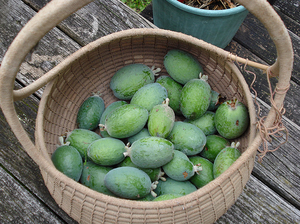
While fruit yield is dependent on the type of fruit being grown and the particular variety, there are a number of generic ways in which you can influence fruit growth favourably, in order to increase the amount of fruit in a growing season.
Here are some of the ways to improve fruit yield:
Steps[edit | edit source]
- Protect the fruit tree, vine or bush from pest damage. Depending on where you live, the type of pest will obviously vary but some common ones are insects and birds. In some areas, mammals such as squirrels, fruit bats and rats or marsupials such as possums can be a problem.
- Use netting to prevent birds from taking fruit.
- Make fruit trees inaccessible to animals looking for food by using tin ring shields, paint, slippery surfaces, odor repellents, and the like.
- Bunches of grapes can be encased in clean, used pantyhose to protect the grapes from bird attacks.
- Wrap larger individual fruit in paper bags tied over the branches with string. This will work for fruit such as apples and pears. Do not use a plastic bag as this will overheat and destroy the fruit.
- Discourage rodent homes in mulch by pulling up mulch in autumn just enough to loosen it and make it undesirable. Put on more mulch in early winter once the rodents have found new homes elsewhere.
- Use humane traps for pest mammals and marsupials if they continuously ravage your fruit crops. They may need to be relocated but realise that many animals have an instinct for returning to an established territory and learning to live in harmony with them is always your best option.
- Use latex paint in white (diluted) to paint on the trunk of fruit trees susceptible to sunburn or flat-headed borer. To dilute, use the ratio of one part paint and one part water.
- Fertilise regularly and well. Always follow the fertilising instructions for the type of fruit you're growing, making relevant adjustments for the soil type, temperature and latitude at which you're living.
- Avoid pruning fruit trees too heavily. This can encourage lowered resistance to bacteria and other pests. Moreover, learn the correct pruning for the type of fruit; pruning methods differ between trees, vines, bushes, etc. and pruning incorrectly can reduce the following season's fruit crop, as well as introducing disease or stress to the plant.
- Consider using espaliering if you want fruit trees close to the house, within easy reach for regular care. The added benefit is lovely flowering during blossom season, as well as saving space and ease of access to treat problems to the fruit. Often this is a great way to shelter fruit from harsher environmental elements, such as fierce winds or too much cold or heat.
- Tobacco plants can be planted at a certain distance from all your other crops to attract pest insects. Many insects such as aphids are drawn to the nicotine and will no longer be interested in other nearby plants.
Tips[edit | edit source]
- Don't touch the base of fruit trees with mulch. Always leave a gap around the trunk.
- Some pest feeders are very determined; read up on specific sustainable ways to discourage them according to species in your area.
Things You'll Need[edit | edit source]
- Latex paint (white)
- Pantyhose
- Paper bags and string
- Humane traps (optional)
- Organic fertiliser